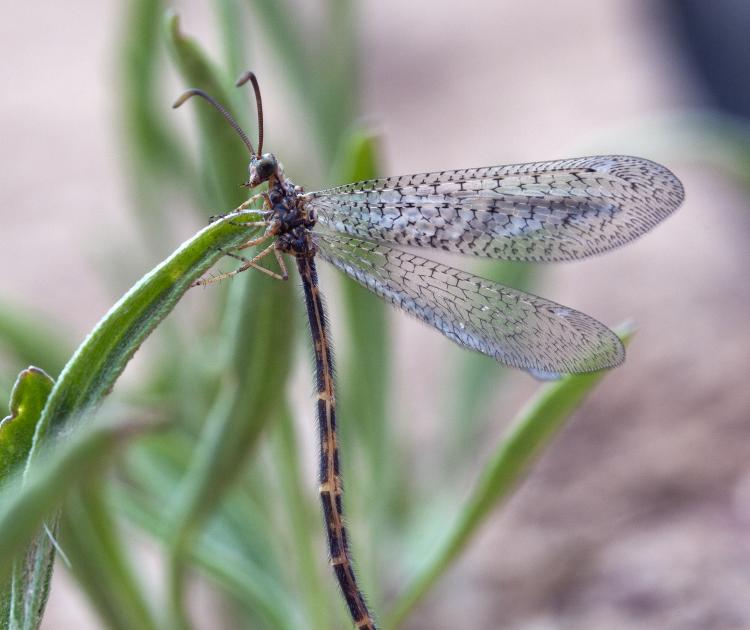An ingenious predator digs pit traps
Something was fluttering clumsily near my tent. That evening in Canyonlands was too cold for sustained insect flight, but nevertheless it repeatedly tried to lift off.
A macro photo provided a close look and convinced me I had never seen anything like it. Scott Ferrenberg, who earned his Ph.D. at the University of Colorado, identified it as an antlion.
Although 2,000 antlion species are found around the world, most people have never seen an adult or a larva. The adults only live about four weeks, preying on smaller insects or eating nectar and pollen.
They look like Dr. Seuss creations — long antennae with large clubs, the head of a praying mantis, wings of a damselfly and abdomen of a dragonfly.
The larvae live two or three years, but they hunt from underground and rarely come to the surface. If you have tried to catch them by digging beneath their traps (I have, always unsuccessfully) you know that they can dig backwards in sand, escaping very quickly.
An adult antlion looks like nothing else — distinctive antennae, the head of a praying mantis, the wings of a damselfly, the abdomen of a dragonfly. Click here or on photo to see larger image. Photo by Jeff Mitton.
A larva looks prehistoric, with a fusiform body, a prothorax that serves as a flexible neck, and giant mouthparts that look like ice tongs with piercing teeth on the inner edges.
Many children and naturalists are familiar with insect traps constructed by larvae. They are conical depressions in the sand, 0.8 to 2.0 inches in diameter. A larva walks continuously in a circle, flicking sand with its head, gradually digging deeper. When the pit reaches appropriate diameter and depth, the larva buries itself at the bottom of the pit, usually with their mouthparts barely exposed.
When an insect, usually an ant, wanders into the pit, the steep, loose sand gives way so the ant slides to the bottom, where the antlion grabs it, injecting venom and enzymes through its hollow mouthparts. Enzymes dissolve the ant's innards within minutes, so the antlion sucks out the fluids and then flicks the empty shell up onto the rim of the trap.
Antlion larvae hatch out in the sand, and are very particular in their choice of habitat in which they dig a trap. A dense aggregation of two antlion species at the base of a cliff in Oklahoma allowed biologists to experimentally tests hypotheses of habitat choice. Nests were very dense, over 50 per square meter, within 6 feet of the base of the cliff, but traps further away were rare. The cliff protected the narrow strip of land from rain and wind.
But if traps were misted with water, or if the trap was partially filled with sand, these traps were soon abandoned. Moistened sand is difficult to dig through, so antlions could not escape quickly. Antlions will not place their traps in sites exposed to wind, for it is too much work, a major expense of energy, to excavate the pit each day. So the density of antlions is highest in fine, dry sand in a site protected from the wind and blowing sand.
Experimental studies of carcasses at the edge of a trap revealed that hunting success increases quickly as the larvae grow from first to third instar, gaining size. The width of the trap is correlated with the length of the larvae, and wider traps intercept more insects. In addition, bigger larvae gain experience and strength, and are more efficient at capturing prey, so they can even kill prey larger than themselves. So the food captured by large larvae is 10 to 50 times greater than by small larvae.
Antlions are practical architects, for they adjust the size and shape of their trap to fit the density and agility of their prey. When insects are rare, antlions dig wider but not deeper traps, to intercept more prey. When prey are especially agile and proficient at escaping, antlions dig deeper traps with steeper walls to improve hunting success.
I am greatly amused to know that antlions and their traps were the inspiration for the monster Sarlacc and its Pit of Carkoon in the movie "Return of the Jedi." I suppose that Luke Skywalker, Han Solo and Chewbacca experienced the horror perceived by a tiny insect, tumbling down a hillside of loose sand into the mouth of an ingenious predator.


